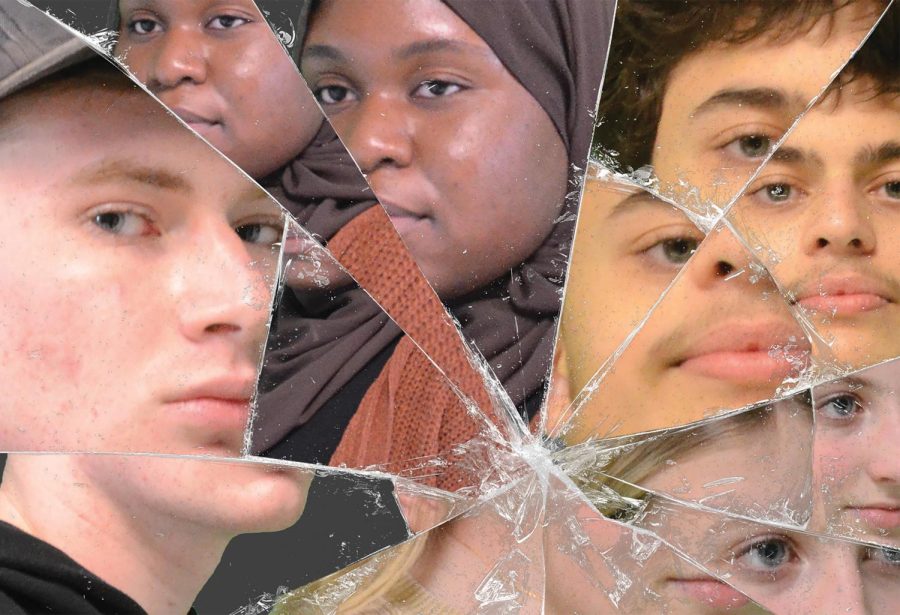Broken beauty
West High students provide their unique perspectives on the impact of beauty standards on themselves and those around them.
Beauty standards impact students at West High, whether they originate from social media or Western beauty ideals.
What makes someone beautiful? At the grocery store, glossy magazines displayed on the shelf scream “How To Look Prettier” in bold, hot pink letters, providing tips on how to look thinner and cover up acne, presenting a single perspective of “beauty.” Merriam-Webster defines the word as “the quality of being physically attractive.” This phrase does not include other factors, such as personality and intelligence.
Adama Katile ’22 explains how the description of beauty should be more inclusive, for it is more than physical appearance.
“For me, beauty is having a great personality — are you friendly? Can you interact with people without making them feel insecure or uncomfortable?” Katile said. “What makes a person really beautiful is the type of energy they give off.”
Beauty standards are often characterized as the ideal attributes that society finds attractive. Like social norms and gender roles, beauty standards evolve over time, but their impact remains the same. Fiona Graber ’25 believes people chase impossible standards in a competition that is only against themselves.
“[Standards] come down to destroying your self-worth,” Graber said. “You don’t feel confident with yourself. Instead, you should be comfortable about how other people should see you.”
Ankur Karandikar ’24 recognizes that even though the harm of beauty standards can be invisible, they still cut just as deep.
“[They] make people who are being bullied or people who do not have the same societal connection feel a lot more left out … which can really affect their mental and social lives, and that just sucks,” Karandikar said.
The constant dread of disapproval and judgment can lead to an overwhelming pressure to adhere to society’s beauty standards. Trey Hotsenpiller ’22 believes beauty standards affect teenagers because they are constantly looking for acceptance from their peers.
“Some people need guidance and … companionship,” Hotsenpiller said. “When you find that, you have to chase it so that [you] can feel better [about yourself].”
According to a 2013 study, body dissatisfaction significantly increased during the transition between middle school and young adulthood. The constant destruction of self-worth can negatively affect physical and mental health, such as eating disorders and depression. Body Dysmorphic Disorder, characterized by the obsessive preoccupation with self-perceived flaws in appearance, affects one in 50 people in the U.S. and often develops during adolescence. Katile confirms that adhering to beauty standards has negative effects on people’s well-being.
“You start to really lose yourself. You start to lose what makes you, you. Your personality starts to change. You start to imitate the people around you instead of having your own sense of self,” Katile said.
In an increasingly digital world, teens are exposed to unrealistic beauty norms daily. Something as simple as scrolling through a social media feed can play a significant role in increased insecurities and self-doubt. A 2019 study conducted by the Natural Library of Medicine found that out of 227 female college students, those who spent more time on social media apps such as Facebook were more likely to compare themselves to others and experience body confidence issues. Social media influencers often perpetuate this issue by not being transparent about their appearance in posts.
“People on social media, like influencers, doctor their body [and do] all [these] altercations and even Photoshop. They definitely [set] the bar for people in real life, which does not translate at all,” Hotsenpiller said. “It’s just really problematic because people expect too much out of the everyday person.”
When it comes to gender, people across the spectrum struggle with different societal pressures on beauty. However, these criteria are next to impossible to reach for some, especially by healthy means. Female bodies have historically been scrutinized over, especially in terms of proportionate facial features and body hair.
“Women have pressure to fit under a double standard,” Hotsenpiller said. “Like their makeup — you wear it, you look good, [but] then why would you wear it? Is your face not good enough?”
Meanwhile, men have concerns surrounding height, balding, wrinkles, body hair and athletic fitness. According to HealthLine, the competitive mentality in men’s fitness can often lead to overexertion and overeating. Toxic masculinity, referring to the stereotypical male notion of dominance and aggression, also plays a role in the beauty world stigmatizing men that wear makeup. Body image affects people, regardless of gender.
A closer look into the past of beauty standards unveils a long history of racism and classism, especially in the U.S.
“Colorism, even in our own community, falls subject to the beauty standard that a certain group has put on us, and even today, we can see it,” Katile said.
The divide of light versus dark skin tones has been present for many years. As stated in the National Library of Medicine, darker enslaved people worked under harsher conditions in the fields than those with lighter skin tones working in the house, creating a sense of disparity. Color discrimination continued into the 1900s, with many public areas following the brown paper bag principle as a test of admission; a brown paper bag was held against an individual’s skin, and they were only allowed entry with a fairer complexion.
Graber believes it is important to remember everyone has insecurities; they stem from the innate human impulse to be respected, accepted and loved.
“Be yourself and don’t be afraid to show who you really are instead of just trying to fit in,” Graber said. “If you reach out to somebody and talk about it, they will reassure you that it’s not just you.”
According to the Mental Health Foundation, body dissatisfaction can occur from relationships with family and friends and exposure to media and societal pressure to match an ideal body type. Karandikar acknowledges it is important for individuals to take a step back and realign priorities.
“Don’t focus on what others are doing … peer pressure, don’t listen to them. Just focus on your own needs and goals in life and majorly pursue those to the maximum,” Karandikar said.
Hotsenpiller says the first step in defying society’s norms is to believe in yourself, which plays a major role in increasing self-esteem and overall happiness.
“Do things that make you feel more confident in yourself, just for yourself and not other people,” Hotsenpiller said. “Express yourself how you want to.”
Katile believes it is important for society to change the narrative surrounding beauty and rewrite the definition.
“Let’s teach our younger generation that it’s okay to be yourself,” Katile said. “Especially during high school … [That’s] where the pressure to be ‘perfect’ really does start seeping into your head, but it is also helpful [to have] constant reminders that ‘No, you are beautiful.’”
Your donation will support the student journalists of West High School. Your contribution will allow us to purchase Scholarship Yearbooks, newsroom equipment and cover our annual website hosting costs.

(she/her) Kamakshee Kuchhal is a senior at West High School and is super excited for her third (and last) year on West Side Story Print Staff. Besides...

(she/her) Jane Lam is a senior at West High. This is her third year on staff reporting for the print publication. As an assistant copy editor, she loves...

(she/they) Kailey Gee is a senior at West High, and this is their third year on staff. She's working as the Co-Print-Editor-in-Chief with Hanah Kitamoto....




